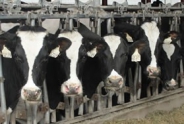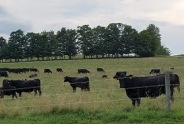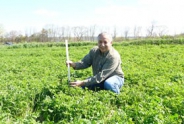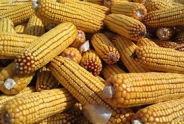Forage Quality
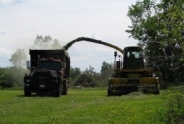 Knowing when to start first cutting haycrop can be a challenge. Harvest can not be tied to a particular calendar date but instead is dependent on heat and soil moisture. Alfalfa height has proven to be the best indicator of alfalfa and grass quality in the field and can give producers a heads up as to when to harvest.
Knowing when to start first cutting haycrop can be a challenge. Harvest can not be tied to a particular calendar date but instead is dependent on heat and soil moisture. Alfalfa height has proven to be the best indicator of alfalfa and grass quality in the field and can give producers a heads up as to when to harvest.To give producers some idea of when to start harvesting first cutting, the CNY Dairy, Livestock and Field Crops Team staff measures alfalfa height on over 55 fields across the eight counties. Those locations were chosen to reflect the diversity of heat, elevation, and soil moisture found in our area.
FORAGE QUALITY CATEGORIES
Field Crop Update June 5, 2025
Erik Smith, Area Field Crop Specialist/Team Leader
Central New York Dairy and Field Crops
Field Crop Update May 21, 2025
Erik Smith, Area Field Crop Specialist/Team Leader
Central New York Dairy and Field Crops
Field Observations, First Cutting Forage Quality, and Growing Degree Days (returning next week)
Field Crop Update May 13, 2025
Erik Smith, Area Field Crop Specialist/Team Leader
Central New York Dairy and Field Crops
1st Cutting Forage Quality Update ~ May 21, 2024
Erik Smith, Area Field Crop Specialist/Team Leader
Central New York Dairy and Field Crops
1st Cutting Forage Quality Update ~ May 14, 2024
Erik Smith, Area Field Crop Specialist/Team Leader
Central New York Dairy and Field Crops
1st Cutting Forage Quality Update ~ May 7, 2024
Erik Smith, Area Field Crop Specialist/Team Leader
Central New York Dairy and Field Crops
1st Cutting Forage Quality ~ April 29
Erik Smith, Area Field Crop Specialist/Team Leader
Central New York Dairy and Field Crops
1st Cutting Forage Quality Update ~ May 16, 2023
Erik Smith, Area Field Crop Specialist/Team Leader
Central New York Dairy and Field Crops
1st Cutting Forage Quality Update ~ May 8, 2023
Erik Smith, Area Field Crop Specialist/Team Leader
Central New York Dairy and Field Crops
1st Cutting Forage Quality Update ~ April 26, 2023
Erik Smith, Area Field Crop Specialist/Team Leader
Central New York Dairy and Field Crops
1st Cutting Forage Quality Update ~ May 3, 2023
Erik Smith, Area Field Crop Specialist/Team Leader
Central New York Dairy and Field Crops
1st Cutting Forage Quality Update ~ May 24, 2022
Erik Smith, Area Field Crop Specialist/Team Leader
Central New York Dairy and Field Crops
1st Cutting Forage Quality Update ~ May 17, 2022
Erik Smith, Area Field Crop Specialist/Team Leader
Central New York Dairy and Field Crops
This is our third week of monitoring 1st cutting for quality in 2022. If you are not familiar with our procedures, we use alfalfa height to predict Neutral Detergent Fiber (NDF) for alfalfa, alfalfa/grass mixed and grass stands.
1st Cutting Forage Quality Update ~ May 10, 2022
Erik Smith, Area Field Crop Specialist/Team Leader
Central New York Dairy and Field Crops
1st Cutting Forage Quality Update ~ May 3, 2022
Erik Smith, Area Field Crop Specialist/Team Leader
Central New York Dairy and Field Crops
1st Cutting Forage Quality Update ~ May 24, 2021
Erik Smith, Area Field Crop Specialist/Team Leader
Central New York Dairy and Field Crops
1st Cutting Forage Quality Update ~ May 17, 2021
Erik Smith, Area Field Crop Specialist/Team Leader
Central New York Dairy and Field Crops
1st Cutting Forage Quality Update ~ May 10, 2021
Erik Smith, Area Field Crop Specialist/Team Leader
Central New York Dairy and Field Crops
1st Cutting Forage Quality Update ~ May 3, 2021
Erik Smith, Area Field Crop Specialist/Team Leader
Central New York Dairy and Field Crops
1st Cutting Forage Quality Update ~ April 26, 2021
Erik Smith, Area Field Crop Specialist/Team Leader
Central New York Dairy and Field Crops
1st Cutting Forage Quality Update ~ May 26, 2020
Kevin Ganoe, Area Field Crop Specialist
Central New York Dairy and Field Crops
1st Quality Forage Quality Update ~ May 19, 2020
Kevin Ganoe, Area Field Crop Specialist
Central New York Dairy and Field Crops
1st Cutting Forage Quality Update ~ May 12, 2020
Kevin Ganoe, Area Field Crop Specialist
Central New York Dairy and Field Crops
This is our second week of monitoring 1st cutting for quality in 2020. If you are not familiar with our procedures we use alfalfa height to predict Neutral Detergent Fiber (NDF) for alfalfa, alfalfa/grass mixed and grass stands. Alfalfa height has proven to be a reliable indicator of NDF values in the field.
1st Cutting Forage Quality Update ~ May 5, 2020
Kevin Ganoe, Area Field Crop Specialist
Central New York Dairy and Field Crops
This is our first week of monitoring 1st cutting for quality in 2020. If you are not familiar with our procedures we use alfalfa height to predict Neutral Detergent Fiber (NDF) for alfalfa, alfalfa/grass mixed and grass stands. Alfalfa height has proven to be a reliable indicator of NDF values in the field.
First Cutting Monitoring-April 28, 2020
Kevin Ganoe, Area Field Crop Specialist
Central New York Dairy and Field Crops
On April 28, 2020 we began our monitoring of 1st cutting for quality this year. If you are not familiar with our procedures we use alfalfa height to predict Neutral Detergent Fiber (NDF) for alfalfa, alfalfa/grass mixed and grass stands. Alfalfa height has proven to be a reliable indicator of NDF values in the field.
1st Cutting Forage Quality Update ~ May 28, 2019
Kevin Ganoe, Area Field Crop Specialist
Central New York Dairy and Field Crops
This is our fifth and final week of monitoring 1st cutting for quality in 2019. If you are not familiar with our procedures we use alfalfa height to predict Neutral Detergent Fiber (NDF) for alfalfa, alfalfa/grass mixed and grass stands. Alfalfa height has proven to be a reliable indicator of NDF values in the field.
1st Cutting Forage Quality Update ~ May 21, 2019
Kevin Ganoe, Area Field Crop Specialist
Central New York Dairy and Field Crops
1st Cutting Forage Quality Update ~ May 14, 2019
Kevin Ganoe, Area Field Crop Specialist
Central New York Dairy and Field Crops
1st Cutting Forage Quality Update ~ May 7, 2019
Kevin Ganoe, Area Field Crop Specialist
Central New York Dairy and Field Crops
This is the second week of our monitoring and at most locations all grass fields are either ready to be cut or will be in the next week
1st Cutting Forage Quality Update ~ April 30, 2019
Kevin Ganoe, Area Field Crop Specialist
Central New York Dairy and Field Crops
Today began our monitoring of 1st cutting for quality this year. If you are not familiar with our procedures we use alfalfa height to predict Neutral Detergent Fiber (NDF) for alfalfa, alfalfa/grass mixed and grass stands. Alfalfa height has proven to be a reliable indicator of NDF values in the field.
Feeding High Forage Diets Successfully
David Balbian, Area Dairy Specialist
Central New York Dairy and Field Crops
You have probably read or heard of people feeding high forage diets to their dairy herds, but how feasible or practical is it? The feasibility comes in when we are able to also have good productivity. Anybody can feed a high forage diet, but if milk output suffers to any great degree, the benefits will almost always be lost to the economic value of the lost production, even with current milk prices.
Alfalfa Grass Mixes article, Dr. Jerry Cherney
Kevin Ganoe, Area Field Crop Specialist
Central New York Dairy and Field Crops
Silage Management 101-The Basics, Dr. Limin Kung
Kevin Ganoe, Area Field Crop Specialist
Central New York Dairy and Field Crops
1st Cutting Forage Quality Update ~ May 22, 2018
Kevin Ganoe, Area Field Crop Specialist
Central New York Dairy and Field Crops
This is our third week and final week of monitoring of 1st cutting for quality for 2018. If you are not familiar with our procedures we use alfalfa height to predict Neutral Detergent Fiber (NDF) for alfalfa, alfalfa/grass mixed and grass stands. Alfalfa height has proven to be a reliable indicator of NDF values in the field.
1st Cutting Forage Quality Update ~ May 15, 2018
Kevin Ganoe, Area Field Crop Specialist
Central New York Dairy and Field Crops
Our second summary for 2018 shows 70 percent of the fields ready to be cut now if they are all grass and a number of fields that are mixed stands should be cut or will need to be cut before next Tuesday.
Credit to David Balbian, Ashley McFarland, Mark Schmidt, Sarah Ficken, and Bill Gibson for gathering the info in the field.
As always use information in the pdf as a guide to know when to harvest by checking your fields! Next report May 22!
1st Cutting Forage Quality Update ~ May 8, 2018
Kevin Ganoe, Area Field Crop Specialist
Central New York Dairy and Field Crops
May 8, 2018 began our monitoring of 1st cutting for quality this year. If you are not familiar with our procedures we use alfalfa height to predict Neutral Detergent Fiber (NDF) for alfalfa, alfalfa/grass mixed and grass stands. Alfalfa height has proven to be a reliable indicator of NDF values in the field.
May 23, 2017 First Cutting Forage Quality Summary
Kevin Ganoe, Area Field Crop Specialist
Central New York Dairy and Field Crops
This is our fourth and final week of monitoring of 1st cutting quality for 2017. If you are not familiar with our procedures we use alfalfa height to predict Neutral Detergent Fiber (NDF) for alfalfa, alfalfa/grass mixed and grass stands. Alfalfa height has proven to be a reliable indicator of NDF values in the field.
May 16, 2017 First Cutting Forage Quality Summary
Kevin Ganoe, Area Field Crop Specialist
Central New York Dairy and Field Crops
This is our third week of monitoring of 1st cutting quality for 2017. If you are not familiar with our procedures we use alfalfa height to predict. Neutral Detergent Fiber (NDF) for alfalfa, alfalfa/grass mixed and grass stands. Alfalfa height has proven to be a reliable indicator of NDF values in the field.
May 9, 2017 First Cutting Forage Quality Summary
Kevin Ganoe, Area Field Crop Specialist
Central New York Dairy and Field Crops
Growth has slowed this week as there has only been an average increase in alfalfa height of three inches. A few fields barely gained an inch.
Take a look at the tables in the pdf for locations near you but more importantly get out and look at your own fields. It may be too wet to be in the field but it doesn't mean you shouldn't take the time to prioritize which fields need to be cut first or maybe which fields are past prime and need to be left and cut later for lower quality uses.
May 2, 2017 First Cutting Forage Quality Update
Kevin Ganoe, Area Field Crop Specialist
Central New York Dairy and Field Crops
We have begun monitoring of 1st cutting for quality this year. If you are not familiar with our procedures we use alfalfa height to predict Neutral Detergent Fiber (NDF) for alfalfa, alfalfa/grass mixed and grass stands. Alfalfa height has proven to be a reliable indicator of NDF values in the field.
5-10-2016 First Cutting Forage Quality Summary
Kevin Ganoe, Area Field Crop Specialist
Central New York Dairy and Field Crops
This is the second week of 1st cutting for quality this year. If you are not familiar with our procedures we use alfalfa height to predict Neutral Detergent Fiber (NDF) for alfalfa, alfalfa/grass mixed and grass stands. Alfalfa height has proven to be a reliable indicator of NDF values in the field.
5-3-2016 First Cutting Forage Quality Summary
Kevin Ganoe, Area Field Crop Specialist
Central New York Dairy and Field Crops
We have begun monitoring of 1st cutting for quality this year. If you are not familiar with our procedures we use alfalfa height to predict Neutral Detergent Fiber (NDF) for alfalfa, alfalfa/grass mixed and grass stands. Alfalfa height has proven to be a reliable indicator of NDF values in the field.
5-26-2015 1st cutting update
Kevin Ganoe, Area Field Crop Specialist
Central New York Dairy and Field Crops
This is the third and last monitoring report for 1st cutting quality for this year. If you are not familiar with our procedures we use alfalfa height to predict Neutral Detergent Fiber (NDF) for alfalfa, alfalfa/grass mixed and grass stands. Alfalfa height has proven to be a reliable indicator of NDF values in the field.
5-19-2015 1st cutting update
Kevin Ganoe, Area Field Crop Specialist
Central New York Dairy and Field Crops
This is the second monitoring report for 1st cutting quality for this year. If you are not familiar with our procedures we use alfalfa height to predict Neutral Detergent Fiber (NDF) for alfalfa, alfalfa/grass mixed and grass stands. Alfalfa height has proven to be a reliable indicator of NDF values in the field.
5-12-2015 1st cutting update
Kevin Ganoe, Area Field Crop Specialist
Central New York Dairy and Field Crops
We have begun monitoring of 1st cutting for quality this year.
Every year is certainly different and 2015 is no exception. We did a dry run last week feeling that the fields were behind enough not to justify reporting. It appears we may just gone through one of the biggest jumps in alfalfa growth since we have started this monitoring. Since last week we had some alfalfa fields grow 9-11 inches where typically large jumps in the past have been in the 7-8 inch range. The warm temperatures really pushed alfalfa growth. However grass growth was atypical due to the dry conditions and is short by 2-4 inches as we now see some heading out. This is a reminder that grass may be behind in growth (yield) but it isnít behind in maturity or fiber accumulation. So check your all grass or mostly grass fields there is a good chance they may need cut. Even mixed stands should be given some scrutiny!
As always use information in the attached table as a guide to know when to harvest by checking your fields! Next report May 19!
5-27-2014 1st cutting update
Kevin Ganoe, Area Field Crop Specialist
Central New York Dairy and Field Crops
This is Week Three of our 1st cutting forage quality monitoring and last for the 2014 growing season.
As of this date all fields in our monitoring program should have been harvested if they were 100% grass and all but nine if they were a 50/50 mix. By next Tuesday all but five fields if they are a 50/50 mix and all but nine if they are 100% legume should be harvested. Given the number of fields that should be harvested in the next week we will end the monitoring program for this year.
5-20-2014 1st cutting update
Kevin Ganoe, Area Field Crop Specialist
Central New York Dairy and Field Crops
This is Week Two of our 1st cutting forage quality monitoring for the 2014 growing season.
Alfalfa grew 5.2 inches taller on average this week. Of the 69 sites monitored 82% should be cut if they are pure grass stands and 13% of the sites if they are a 50/50 alfalfa grass mix. So get out and look at your fields! As always use information in the attached table as a guide to know when to harvest by checking your fields! Next report May 27!
5-13-2014 1st cutting update
Kevin Ganoe, Area Field Crop Specialist
Central New York Dairy and Field Crops
We have begun monitoring of 1st cutting for quality this year.
It is interesting to note that we are behind by about 10 days compared to some of our previous starts. As you can see at a number locations grass stands should be ready to harvest now or momentarily. But note the location differences as some fields may not be ready for another week. Elevation plays slight role here but not as much as you might think. As always use information in the attached table as a guide to know when to harvest by checking your fields! Next report May 20!
5-1-2012 1st cutting update
Kevin Ganoe, Area Field Crop Specialist
Central New York Dairy and Field Crops
5-11-2010 1st cutting update
Kevin Ganoe, Area Field Crop Specialist
Central New York Dairy and Field Crops
5-11-2011 1st cutting update
Kevin Ganoe, Area Field Crop Specialist
Central New York Dairy and Field Crops
5-14-2013 1st cutting update
Kevin Ganoe, Area Field Crop Specialist
Central New York Dairy and Field Crops
5-15-2012 1st cutting update
Kevin Ganoe, Area Field Crop Specialist
Central New York Dairy and Field Crops
5-16-2011 1st cutting update
Kevin Ganoe, Area Field Crop Specialist
Central New York Dairy and Field Crops
5-17-2010 1st cutting update
Kevin Ganoe, Area Field Crop Specialist
Central New York Dairy and Field Crops
5-20-2011 1st cutting update
Kevin Ganoe, Area Field Crop Specialist
Central New York Dairy and Field Crops
5-21-2013 1st cutting update
Kevin Ganoe, Area Field Crop Specialist
Central New York Dairy and Field Crops
5-22-2012 1st cutting update
Kevin Ganoe, Area Field Crop Specialist
Central New York Dairy and Field Crops
5-24-2010 1st cutting update
Kevin Ganoe, Area Field Crop Specialist
Central New York Dairy and Field Crops
5-25-2011 1st cutting update
Kevin Ganoe, Area Field Crop Specialist
Central New York Dairy and Field Crops
5-28-2013 1st cutting update
Kevin Ganoe, Area Field Crop Specialist
Central New York Dairy and Field Crops
5-6-2010 1st cutting update
Kevin Ganoe, Area Field Crop Specialist
Central New York Dairy and Field Crops
5-7-2013 1st cutting update
Kevin Ganoe, Area Field Crop Specialist
Central New York Dairy and Field Crops
5-8-2012 1st cutting update
Kevin Ganoe, Area Field Crop Specialist
Central New York Dairy and Field Crops
Combat High Grain Costs by Making High Quality Forage
David Balbian, Area Dairy Specialist
Central New York Dairy and Field Crops
Forage Sampling and Varying Results
David Balbian, Area Dairy Specialist
Central New York Dairy and Field Crops
Sampling errors can vary widely between feeds and between farms.
Forage Shortfalls Again?
Strategies to deal with forage shortfalls
Immature Corn Silage
Dr. Larry Chase from The Department of Animal Science offers the following tips for dealing with immature corn silage:
Upcoming Events
If I'm Not Here Tomorrow: Estate Planning for Young Farm Families with Children
November 5, 2025
Free webinar
Inspired by Annie's: Getting Your Finances in Order for 2026
November 5, 2025
November 12, 2025
Free events. In-person and virtual options.
Dairy Systems and Technology Showcase - Farm Tours
November 6, 2025 : CANCELLED Farm Tour - Creek Acres Farm
Amsterdam, NY
Free event, but registration required. Brand new freestall barn. All attendees must wear clean clothes and boots, and scrub and disinfect footwear upon arrival and before leaving.
November 6, 2025 : CANCELLED Farm Tour - Glenvue Dairy Farm
Fultonville, NY
Free event, but registration required. Under construction 10 robot farm. All attendees must wear clean clothes and boots, and scrub and disinfect footwear upon arrival and before leaving.
November 7, 2025 : Farm Tour - Indian Camp Farm & Dairy
Earlville, NY
Free event, but registration required. Four robot barn and new manure aeriation system. All attendees must wear clean clothes and boots, and scrub and disinfect footwear upon arrival and before leaving.
Announcements
Sign Up for Our Weekly E-Newsletter
We send out a bi-weekly e-newsletter that has announcements, upcoming programs, and opportunities for you! Registration is quick, easy, and free. Click here to sign up today!Farmers Can Join MeatSuite For Free!
MeatSuite.com is a free resource provided by Cornell University where NY meat farmers can create a farm profile and list their bulk (wholes, halves, quarters) and bundled (i.e. Grilling Bundle) meat products.Why should farmers join?
1. It's free and easy!
2. Connect with more local customers. In the past year the MeatSuite.com farm directory had 8,300 visits from New York consumers. Farm profiles get as many as 25 views per month from potential local customers. We also spotlight MeatSuite farms on social media and bring attention and purchases to farms through highlights and giveaways.
How do I join?
Farmers can visit https://www.meatsuite.com/farmers/ to create a free farm profile. You must list at least one product for your farm's profile to go live. You'll also have access to Cornell's free Meat Price Calculator, a helpful tool for pricing your meat to make a profit.
While you're on MeatSuite, check out the "Creating Consumer-Friendly Bulk Meats" publication on the log-in page. It has tips on how to create bulk meat products that are easier for first-time buyers to say "yes" to.
If you have any questions as you create your farm profile or products, we're here to help! Please email Matt LeRoux at mnl28@cornell.edu.

